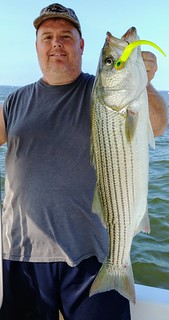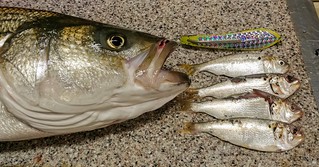Maryland Fishing Report: September 26
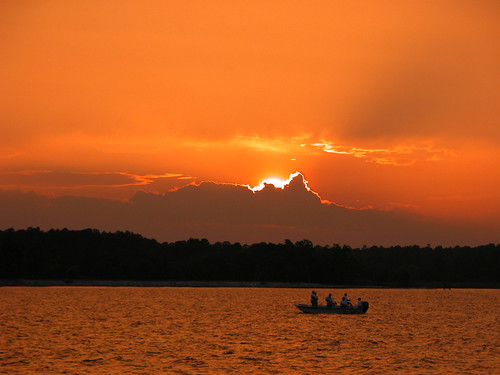
As the sun sets in all its glory over the Tred Avon River, it seems to say goodbye to summer. Photo by Keith Lockwood
With the fall equinox behind us, the days are getting noticeably shorter. There’s no sweeter time of the year – or place to be — than late September and October in Maryland, whether you are a fisherman or a hunter or just someone who likes to enjoy the sights and sounds of autumn.
Forecast Summary: Sept. 26- Oct. 2
After the seemingly endless rain, anglers will be treated to several sunny, cool, calm days from Saturday through Tuesday next week. The cool, rainy and windy weather has continued to mix and cool Chesapeake Bay waters, providing favorable conditions for rockfish. Anglers should continue to seek the best combination of clear, cool, oxygenated waters – which can be found right now from the surface down into deeper waters.
Water temperatures is 68 degrees at the Susquehanna River, 75 degrees at Gooses Reef and 78 at Point Lookout, with more cooling as the week continues. Expect poor water clarity from the high flows coming from most rivers and streams. The Susquehanna River’s muddy water will likely extend below Swan Point. There will be above average tidal currents through Sunday as a result of the full moon Sept. 26.
For the full weekly fishing conditions summary and more detailed and up-to-date fishing conditions in your area of the bay, be sure to check out Eyes on the Bay’s Click Before You Cast.
The upper bay continues to present a mine field of floating debris to boaters and it becomes even more dangerous when wind tossed waves make floating logs harder to see, so be careful out there and take it slow. Waters continue to be stained from runoff and the Conowingo Dam continues to dump a lot of water coming down the Susquehanna.
Fishing for striped bass is very good this week with chumming taking center stage at traditional locations. The 20-foot to 25-foot channel edges at Swan, Love and Podickory points has been very good as well as the Bay Bridge and there has even been some action at the Francis Scott Key Bridge. Smaller striped bass tend to swarm into chum slicks with larger fish holding close to the bottom in back of the slicks. Anglers will find channel catfish holding back there also.
Spot are becoming harder to find this week as water temperatures dip. They can still be found in the lower Magothy River and the shallower side of the Bay Bridge in about 15 feet of water. Live lining is a great option at all of the chumming locations.
The Bay Bridge piers have been a good place to find suspended striped bass and one can either jig, chunk, chum or live line spot for them. At times there has also been some breaking fish near the bridge and if one looks carefully sometimes slicks will reveal the presence of underwater action which depth finders can confirm for some jigging action. Steve Fisher holds up a nice striped bass caught while jigging.
Fishing for white perch has been very good in the tidal rivers for those casting small spinnerbaits and jigs near shoreline structure. Fishing with a bottom rig baited with peeler crab, bloodworms or grass shrimp is a good way to catch them over hard bottom in deeper areas. Channel catfish are very active and can be caught in all of the region’s tidal rivers.
Cooler water temperatures are beginning to have some dramatic changes in our Chesapeake Bay fisheries as they shift towards a fall pattern. Breaking fish are becoming a more common sighting as schools of baitfish move out of the tidal rivers and into the bay. This is a wonderful time of the year for striped bass as they recover from the heat of the summer months and begin to feed heavily.
When breaking fish and diving sea gulls cannot be spotted, striped bass can often be found suspended along shipping channel edges in the bay and various channel edges in the lower sections of the region’s tidal rivers. Depth finders are a fisherman’s bird dog these days to spot suspended fish and to confirm the presence of fish when surface slicks can be spotted. Jigging is popular but trolling can be extremely effective with small spoons, bucktails and hoses behind planers and inline weights. Trolling also targets a mix of striped bass, bluefish and Spanish mackerel. The channel edge from Tolley Point to below Thomas Point has been a great spot to troll lately.
The shallow water striped bass fishing has improved as cooling water temperatures tend to draw fish into the shallower waters. Casting topwater lures, swimbaits and crankbaits are all good choices for spinning gear. Skipping bugs on a floating fly line can offer a lot of fun, Clouser flies on a sinking line or sinking tip are good choices for deeper waters or breaking fish.
White perch fishing in more sheltered areas has been offering a fun option when winds tend to roughen up the bay. Fishing over oyster bottom in deeper areas or around docks and piers with peeler crab, bloodworms or grass shrimp has been a great option. Casting small spinnerbaits, jigs or spinners around shoreline structure with ultra-light tackle is always a fun way to catch white perch.
Trolling a mix of hoses and small spoons has been a good option this week for catching a mix of striped bass, bluefish and Spanish mackerel. Planers are a popular choice to get lures down to acceptable depths along channel edges and the outside edges of breaking fish. The Tangier and Pocomoke sound areas have been two of the better places to find the Spanish mackerel and bluefish.
Chumming has been a good way to target a mix of striped bass and bluefish in the lower Potomac River near St. Georges Island, this area tends to hold the best chumming opportunities this week.
The tidal rivers of the lower Potomac and the lower Patuxent River have been offering good striped bass fishing along shoreline structure for those casting topwater lures, swimbaits and crankbaits. Cooler water temperatures have fish very active in these shallower waters.
Live lining spot along channel edges in the lower Potomac and wherever striped bass can be found suspended has been a very popular way to fish along 20-foot to 25-foot edges. Spot seem to be getting a little itchy these days and have been reported to be moving from location to location. They seem to be a little more stable in the Tangier Sound region. A mix of croaker, bluefish and white perch can also be found in these same areas. There are a few flounder being found along hard channel edges in the Pocomoke and Tangier sound areas.
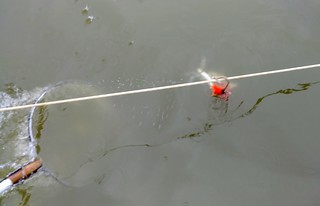
Rich Watts went crabbing in the rain and took this picture of what every crabber loves to see coming up from the depths. Photo by Rich Watts
The large red drum that had provided amazing catch and release action in the Target Ship area seem to have departed for the most part, heading south towards the mouth of the bay. There is of course always hope of catching a lingering red drum or cobia over some of the oyster lumps in the area.
Recreational crabbing in all three regions of the bay is perhaps at its zenith this week. Cooler water temperatures have moved many crabs into shallower waters in the range of 10 feet or so and very actively feeding. A full bushel of large and heavy crabs is a common report from crabbers this week. Fresh chicken necks are standard fare but razor clams tend to catch better. Some are also doing well with white perch fish heads in collapsible traps.
Fall is in the air in western Maryland, and as water temperatures decline, many different species of fish are becoming more active for longer periods of time. At Deep Creek Lake, vacationers’ boat traffic has slacked off and anglers are able to find some peaceful fishing on the lake and good fishing for a variety of fish. Yellow perch, smallmouth bass and walleye can be found along deep grass edges and caught by drifting live minnows. Floating docks are starting to get pulled and those that are left are havens for largemouth and smallmouth bass as they seek shade during the day. Rocky points are good place to look for smallmouth bass and largemouth bass can be found along shoreline structure and in the grassy coves.

A 12-inch trophy brook trout and a colorful wild brown trout collected in the Savage River trophy trout fishing area 2018.
The upper Potomac still has unsafe water levels this week as does the North Branch in the Cumberland area but farther up the North Branch above Luke water levels are acceptable. Many streams and rivers in the western and central regions are experiencing high flows this week and there is rain in the forecast, so keep a watch on water levels. The U.S. Geological Survey offers good information on stream and river water levels online.
Fisheries biologists recently conducted the annual electrofishing survey of the Savage River tailwater trout fishery with assistance from the department’s Hatcheries Division, Maryland Forest Service, Maryland Biological Stream Survey and Wildlife and Heritage Service. Native brook trout, wild brown trout, and a few rainbow trout inhabit the river. Two trophy trout fishing areas are in place: the upper half of the river is fly-fishing only while the lower half to the river is open to spinning or fly-fishing gear using single hook artificial lures or flies. Regulations include a two trout per day creel limit; 18-inch minimum size on brown trout; 12 inch minimum size on brook trout; and no size restriction on rainbow trout. This regulation makes available many quality-sized trout for anglers to enjoy. The average adult combined species trout density was 1,136 trout per mile. Reproduction for both brook and brown trout was considered “moderate” with an average of 577 combined species young of year per mile in 2018.
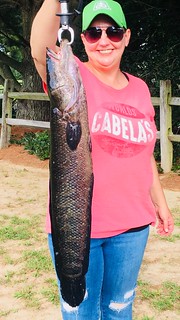
Jessica Thomas recently caught this 7.5 pound northern snakehead in Dorchester County waters. Photo courtesy of Jessica Thomas
The cooler weather is making for some delightful fishing despite having to dodge rain and windy conditions at times. Largemouth bass are becoming very active for longer periods during the day and can be found near grass and sunken wood. Grass beds are declining, so any existing ones are good places to target. Baitfish are finding fewer places to hid and more vulnerable to predation. In tidal areas a falling tide is one of the best times to target the outside edges of grass and spatterdock beds. Spinnerbaits, small crankbaits, tubes and various soft plastics are good choices for baits. Northern snakeheads are becoming increasingly common in most of the tidal rivers and creeks in Maryland and they offer some fun action and good eating. They can be caught on a variety of lures and live minnows are a good bet also, but buzzbaits seem to drive them crazy.
Fishing for blue catfish has been described as epic by a few anglers that reported in from fishing below the Route 301 Bridge recently. Lower salinity values in the lower Potomac have the blue catfish as far south as the mouth of the Wicomico River. It would seem anywhere from there to the Wilson Bridge provides excellent fishing for blue catfish. They make excellent table fare and freeze well.
The surf has been a bit rough lately but there is good fishing this week. Perhaps one of the more exciting events is the passing of large red drum past the Ocean City and Assateague beaches. Generally about the third week of September they provide some exciting catch and release action for surfcasters. Several have been caught and released in the past few days on cut bait. Kingfish are still being caught in the surf and more than a few anglers have been catching pompano.
At the inlet and Route 50 Bridge area, sheepshead are being caught at the South Jetty and to a lesser extent at the North Jetty. Flounder are being caught in the area by those casting Gulp baits or drifting live mullet, spot or small menhaden. The back bay channels are also providing plenty of flounder action and as waters cool, these channels will be the highways used to pass out of the back bay areas and out the inlet in the next few weeks.
The wrecks and lumps near the 30 fathom line are providing good flounder and sea bass fishing this week. Those who are trolling are catching dolphin in the area and bluefish are showing up now and then. Conditions have been windy lately making for some tough fishing conditions.
Out at the canyons such as Poormans and the Norfolk white and blue marlin are being caught and the action is expected to continue if fish from up north make their way south. There have been excellent catches of large dolphin at the Rock pile and the 30 fathom lumps. Yellowfin tuna will hopefully be passing through our region soon from north of us.
“You know there is never a time when I’m not fishing- just days when I can’t do it on the water.” – Jay Hill
Keith Lockwood has been writing the Fishing Report since 2003 and has had a long career as a fisheries research biologist since 1973. Over the course of his career he has studied estuarine fishery populations, ocean species, and over a decade long study of bioaccumulation of chemicals in aquatic species in New Jersey. Upon moving to Oxford on the eastern shore of Maryland; research endeavors focused on a variety of catch-and-release studies as well as other fisheries related research at the Cooperative Oxford Laboratory. Education and outreach to the fishing public has always been an important component to the mission of these studies. Keith is an avid outdoorsman enjoying hunting, fishing, bird dogs, family and life on the eastern shore of Maryland.

